Launching into Washington State’s Bellingham Bay from the skinny Fairhaven launch ramp, I was optimistic about having a relaxed trip over the next few days in the middle of May. My plan was simple: make for the northern string of islands in the San Juans that stand as diminutive guards against the Strait of Georgia, and spend a few days on the water shaking down the camp-cruising setup onboard my family’s 25-year-old Haven 12 1⁄2, LAZYDOG. With the forecast predicting only a 10-knot southerly under sunny skies and a progressively diminishing breeze over the following two days, I was eager to make the most of this early-season weather window, with lots to test out on LAZYDOG before it would be all-systems-go for longer trips over the summer months.
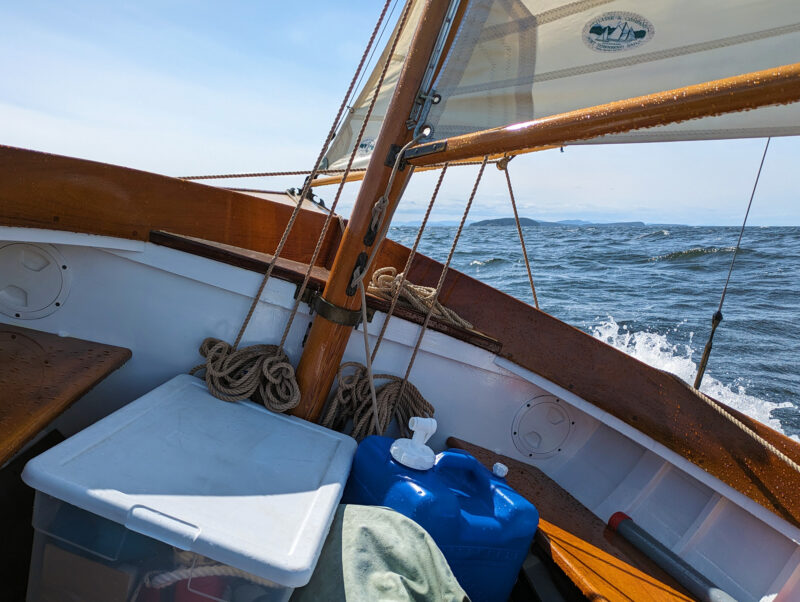 Photographs by the author
Photographs by the authorLAZYDOG reaches across Rosario Strait with Matia Island in the distance. The large watertight bulkhead forward of the mast gives peace of mind in rough seas. but has no access for gear. Anything that doesn’t fit in a small aft compartment must sit on the floorboards between the helm and the halyards.
After an easy launch, I slowly sailed out into the bay past the blue-and-white Alaska ferry, docked at its southern terminus and sporting the Big Dipper and Polaris on its smokestack. Out past the industrial Fairhaven docks I set the beige marconi main and self-tacking jib for a close reach across Bellingham Bay toward Hale Passage, the 1-nautical-mile-wide gap between Portage and Lummi islands. Before long, the crumbly white bluffs along Portage’s south shore loomed above me and I cracked off my course, letting the jib club swing over to windward as LAZYDOG settled into a wing-and-wing run northbound. For the next 5 miles LAZYDOG romped down the passage, first nearing the steep and densely forested evergreen slopes of Lummi Island before jibing back toward The Portage, a slender sandy spit linking Portage Island to the Lummi Reservation on the mainland. Playing downwind with small puffy clouds shining against the blue sky overhead and hardly anyone out on the water, I couldn’t have been more pleased with how this shakedown cruise had begun.
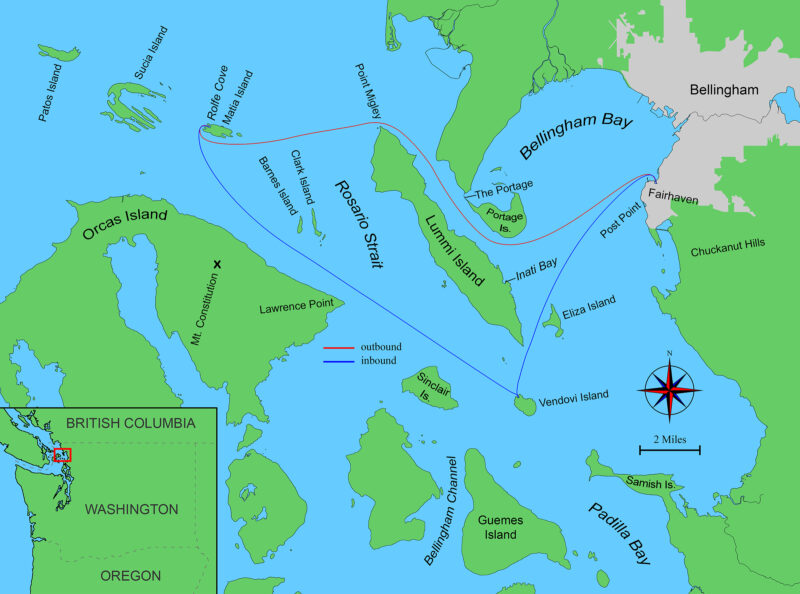 Roger Siebert
Roger Siebert.
When I rounded the dark seaweed-strewn rocks of Point Migley at the northern end of Lummi Island and entered Rosario Strait, the hands-on sailing began. My time in Hale Passage had been leisurely with downwind sailing in 10 knots, but now LAZYDOG’s bow was punching through the waves on her new beam-reach course. The 15- to 20-knot southerly was battling against a northerly ebb current that combined for a steep and tightly packed wave pattern that sent spray high enough off the bow to clear the varnished mahogany coaming and soak me at the helm. With the mellow forecast, I hadn’t planned on tasting salt on my lips during this passage. Rosario Strait has a reputation as a body of water with little sympathy for small open boats, or their soaked skippers, so I turned to a broad reach and left the helm to a tiller bungee while I pulled on more layers and boots. Now more properly attired, I set about crossing the 4 miles of open water at the northern mouth of the Strait. I dropped the centerboard, brought the bow up onto a close westward reach, and set my sights on my next obstacle: crossing the Rosario shipping lane. As I neared the boundary, a tug-and-tow passed by, crushing the swell with its bow as it churned north. Otherwise, it seemed to be a sleepy day for commercial traffic, and I only had to duck behind the stern of a lone northbound tug during my crossing. While LAZYDOG remained remarkably stable, not heeling excessively while still under full sail, she required quick and constant working of the mainsheet, and taking the waves directly on the beam gave me a chilly soaking every few minutes. My only recourse from the steepest sets, which came through in groups of nine to ten larger waves every few minutes, was to diverge from my beam-reach course and run downwind with the waves before correcting my course again.
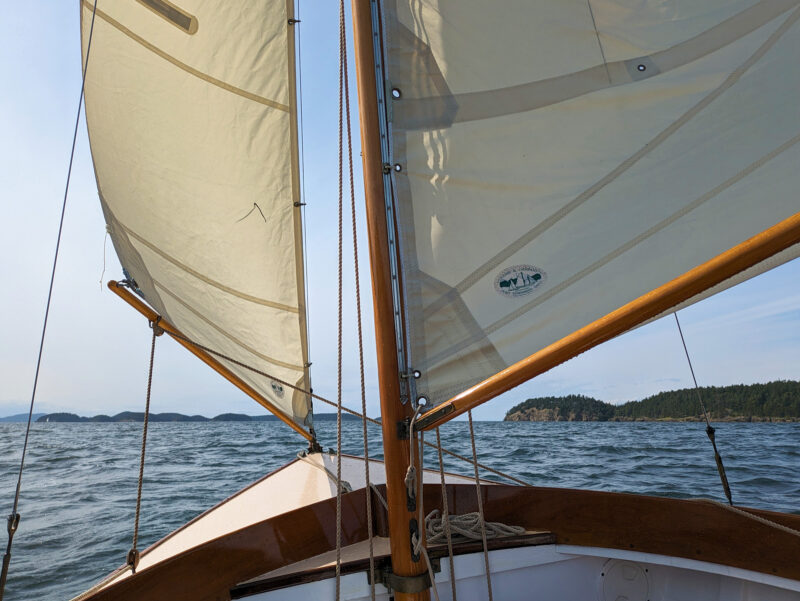
Rolfe Cove, my destination for the day, lies just around the Matia Island headland, visible under the boom. The jib is flown with a club, which keeps the foot stretched out for downwind sailing. It is particularly handy when running wing-on-wing.
I occasionally retrieved my phone from the drybag clipped near my feet to use a charts app to check our heading, confirm buoy sightings, and get a gauge of speed over ground.
As LAZYDOG romped across the Strait at a steady 6 knots, hitting upward of 8 knots running down the steepest waves, I fell into the rhythm of each passing set, first easing off the sheet to gently bear down with the swell and, once it had stopped rushing under the hull, turning back up again to keep the boat speed up. It felt like linking ski turns through a steep mogul field. LAZYDOG’s buoyant bow danced among the waves with plenty of responsiveness on the helm, though I inevitably slipped up on my steering through an extra-tall set that slapped the windward corner of the transom as I belatedly steered the bow down. The spray smacked the back of my head and soaked my hat. I looked backward more frequently for the approaching sets for the remainder of the passage. Mesmerized in this ritual for about an hour, I soon saw that the yellow buoy marking the center of the shipping lane now lay off my starboard quarter, indicating that I had cleared the channel. I pressed on into the lee of the towering ridge of Orcas Island’s 2,400′-tall Mount Constitution; the wind dropped to 10 knots.
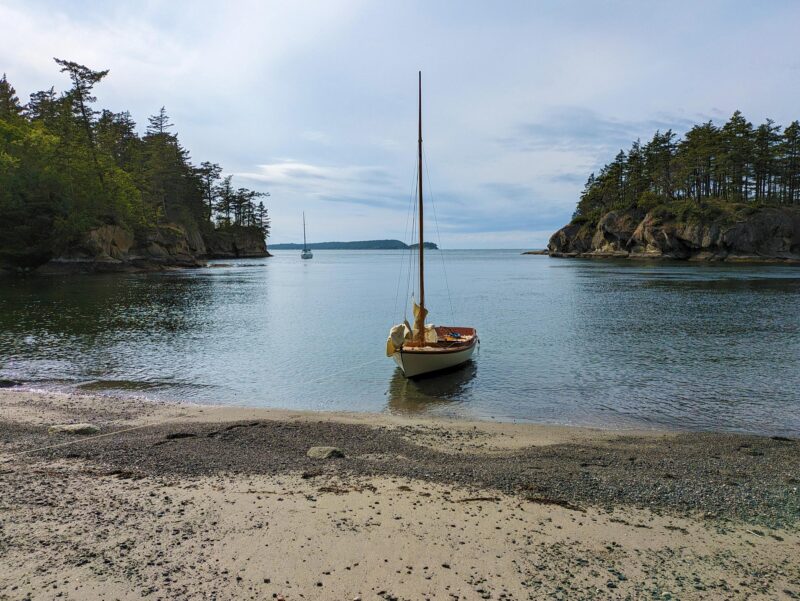
After the trying crossing of Rosario Strait, I arrived exhausted on Matia Island. The sandy beach in Rolfe Cove was a very welcoming place to beach the boat. On the horizon beyond the mouth of the cove is Sucia Island.
With the lighter wind the waves slackened, and the steeper sets no longer threatened to overtop the gunwale. I ran wing-on-wing once more and passed under the longer southern side of Matia Island to reach the entrance of Rolfe Cove on the western end. I short-tacked into the cove and found the dock was crowded with nine white-hulled cruising sailboats rafted up two and three across. I had planned to spend the night at anchor but was nevertheless surprised to see the cove so busy only a few weeks into May. In between the tall rocky flanks of the cove the wind died, so I dropped the sails and rowed the last 250 yards toward the beach. About 50′ before the shore, I tossed out my first anchor to let it settle in the mud before rowing ashore. Just as the keel grounded gently with a shushing sound, I stepped off the bow into 1′ of water. I set my second anchor high in the sand just beneath the mossy ground at the edge of the treeline.
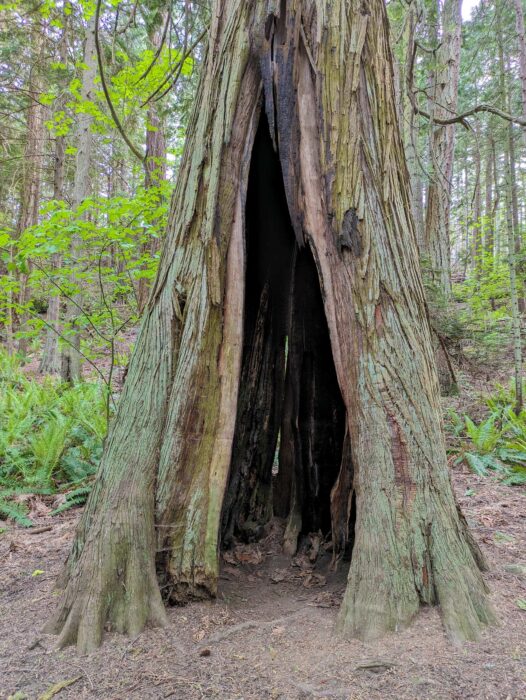
While this old-growth western red cedar was slightly worse off than most of its peers, it was still alive despite the fire damage to its lower trunk. As part of the preservation efforts on Matia Island, a state park and national wildlife refuge, campfires and wood collecting are banned.
During the windy crossing of Rosario, I’d strewn spare clothing layers, food bags, and a rat’s nest of lines on the floorboards. The mess was a reminder that I’d be safer if I kept the boat tidy while underway. I coiled sheets, corralled loose water bottles, and rearranged the cockpit to prepare for the night ahead. It didn’t take long—everything is within arm’s reach in LAZYDOG’s 7′-long cockpit. I was desperately hungry after the bouncy hands-on crossing that had left me no time for snacking. In the quiet shelter of Rolfe Cove’s high-walled shoreline, I extracted from a salt-encrusted dry bag an apple and home-baked cranberry-molasses bread and quickly devoured them.
With things tidied up onboard and my hunger at bay, I went ashore to explore Matia. The 1⁄4-square-mile island’s only trail is a loop that twists 1 mile through the western red cedars and Douglas firs. Long and skinny ridgelines topping out at over 150′ run the length of the island and can be seen from the trail below them in the moss-covered valley. In this old-growth forest the crowns of massive trees with trunks that would require several people to encircle them rise well clear of Matia’s ridgelines. Within the valley, the epiphyte-laden boughs of the big-leaf maples and the grand fir saplings poking up from mossy nurse logs are undisturbed by the wind in the Straits, yet I could smell the salt in the still air that hung in the valley. I sat on a fallen log deep in the valley amid the waxy-deep green of the abundant salal and celeste-green of the fir needles shimmering overhead. A varied thrush chick alighted on a log not 10′ away. With baby down feathers still interspersed between its developing orange and black plumage, it eyed me from different angles as it hopped along the log. After a few minutes of exchanged glances, the thrush flew noiselessly away into the dense underbrush, and I carried on my own way down the loamy path.
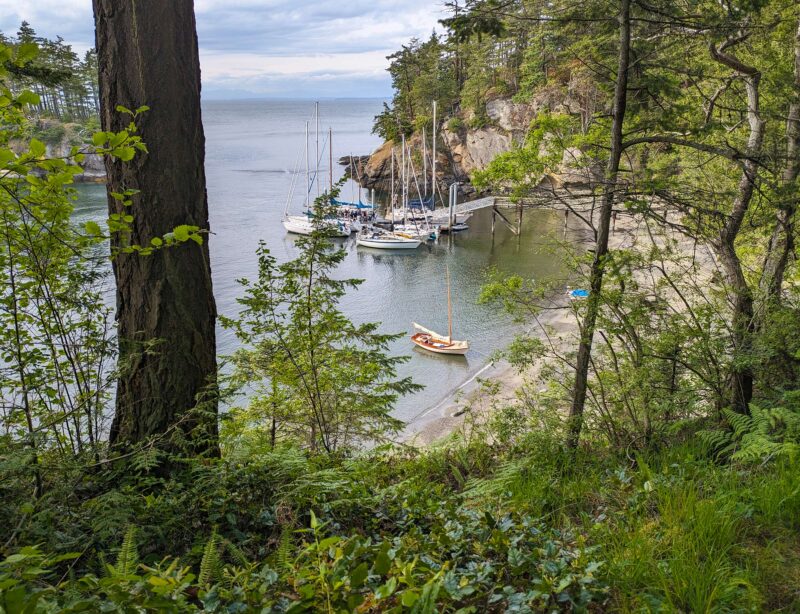
Seen from the cliffside trail along the cove, LAZYDOG cuts a diminutive figure compared to the cruising boats at the park dock.
Farther along the trail, I met a family of three who had crossed Rosario Strait about an hour before me in their Pelican dinghy in similar windy conditions. They told me about a dicey jibe they’d experienced in the steep and crowded waves when the peak of their gaff-rigged mainsail had unexpectedly backwinded across the mast and left the boom on the opposite side of the boat. They were planning to relax for a few days on Matia before heading out again, and after hearing about their travails I couldn’t blame them for taking a long break. LAZYDOG had fully displayed her seaworthiness by sparing me a similar experience, and further proved to me that despite most Haven 12 1⁄2s never venturing far from their home ports, they do in fact make seaworthy sail-and-oar cruising boats.
Back in Rolfe Cove, I chatted with the gaggle of around 20 sailors on the dock. They were a cruising club from Bellingham, who open their season with a cleanup trip to Matia every spring. I was heartened to know that local cruisers are embracing a duty of care to help preserve the San Juan Islands. They had watched LAZYDOG sail into the cove and invited me to their dockside potluck.
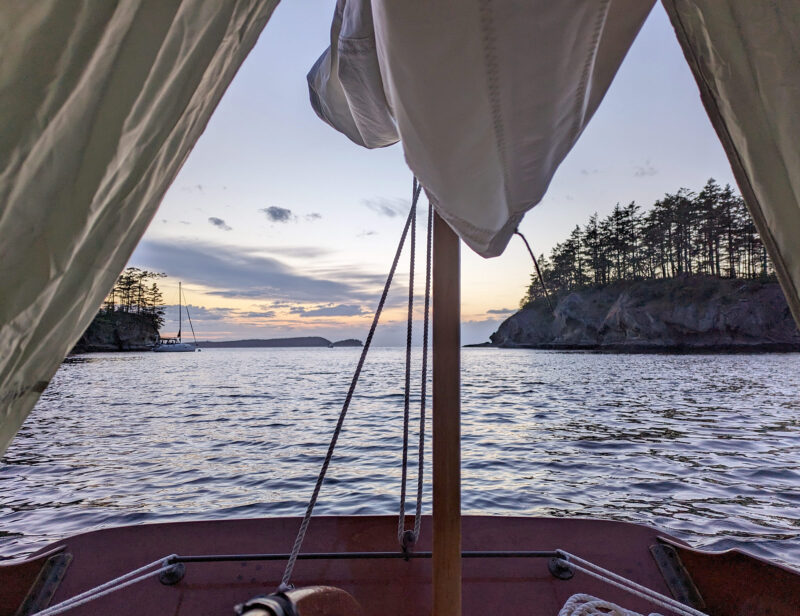
My somewhat flappy tarp over the boom did offer me a view of the sun setting beyond a thick layer of clouds hanging above Canada’s Gulf Islands. Rolfe Cove is narrow and has steep, high sides that offered good protection from the strong southerly that had blown all day.
After a while, I left their company and waded back out to LAZYDOG for the night. The tide had fallen throughout the evening and the 18″ keel was gently lodged in the sand. I had been unsure before the trip if my sailing boots would be tall enough to keep my feet dry while leaving and returning to LAZYDOG on beaches, but they had 2″ to spare before they would become overtopped. A gentle push set the boat floating again. Once I had hopped aboard the foredeck and stepped into the cockpit, it was time to move to deeper water for the night. I paid out the shoreside anchor rode while hauling in the one set deeper in the mud-bottomed cove until LAZYDOG was in about 15′ of water. With only an 8′ tidal swing coming overnight, I would rest easy.
I set about rigging my test tarp over the boom. It was an unwieldly 12′ square poly-tarp originally purchased for car-camping trips, but it was the only one I had on hand when pulling gear together in my tiny apartment. Folding it in half and then folding up one-fourth of the length gave me a tarp of 6′ by 9′, about the right size to sit over LAZYDOG’s boom, which was held by a taller-than-normal crutch I had made. I ran tiedowns as best I could from stem to stern, but my origami cover was far from taut. As darkness fell upon the cove, the exhaustion of a long day set in, and I was soon tucked alongside the centerboard trunk. Having never slept aboard prior to this trip I was thankful that the sleeping pad and my 6′ 2″ frame fit as well in practice as my shoreside tests had suggested.
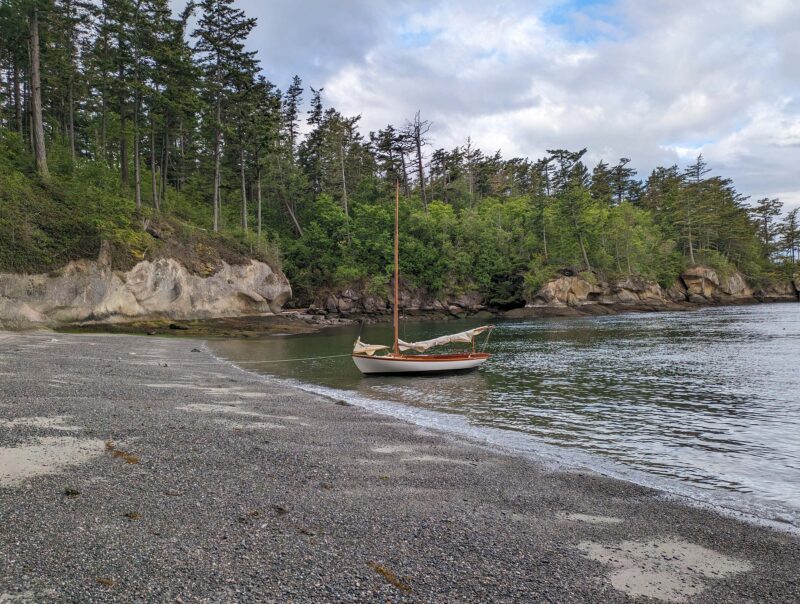
LAZYDOG sits afloat between her two anchors. A 4-lb anchor sits in the mud about 60′ behind the boat, and a 2.5-pounder is some 40’ up the beach deep in the sand. Since the keel prevents her from being fully beached, I left her with a couple of feet of water under the bow.
The tarp flapped throughout the night, but despite its incessant addition to the sound of lapping water, I awoke well rested to a dawn chorus of robins and chickadees. I peered west out of the triangular opening between the tarp and transom and saw a 10-knot westerly rolling into the mouth of the cove from the sunrise-lit hills of Sucia Island. The breeze was far greater than the light air forecast for the day, and I immediately knew I could not let it go to waste. I was quick with my breakfast, packed up my bedding, and pulled LAZYDOG back to the beach. I was soon striding along the loop trail to check conditions in Rosario Strait. From Matia’s southeastern bluffs I trained binoculars on the flanking sloped shores of Lummi and Orcas islands and saw consistent but not overly large whitecaps rolling across the Strait. The sea state was much friendlier than the day before, thanks to the morning’s ebb current running with the wind. With unexpectedly lovely conditions for making miles to the south, but such a dismal forecast of variable light wind still predicted for my final day, I’d need to visit Sucia and Patos islands another time. Instead, I set my sights on a visit to Vendovi Island, 12 sea miles to the southeast, before spending the night in Lummi’s Inati Bay, which would leave me only a short jump to Bellingham the following day.
I was soon back onboard LAZYDOG and short-tacked out of Rolfe Cove until I rounded the angled slabs of guano-stained rock protruding from Matia’s western point. Once clear of the cove, I bore off on a broad reach to the southeast and it didn’t take long for LAZYDOG to put the island far off the port quarter. The recreational shrimp-fishing season had just opened, and with the favorable sea state multitudes of small aluminum motor craft dotted the water around me as the shrimpers deployed their traps with yellow buoys.
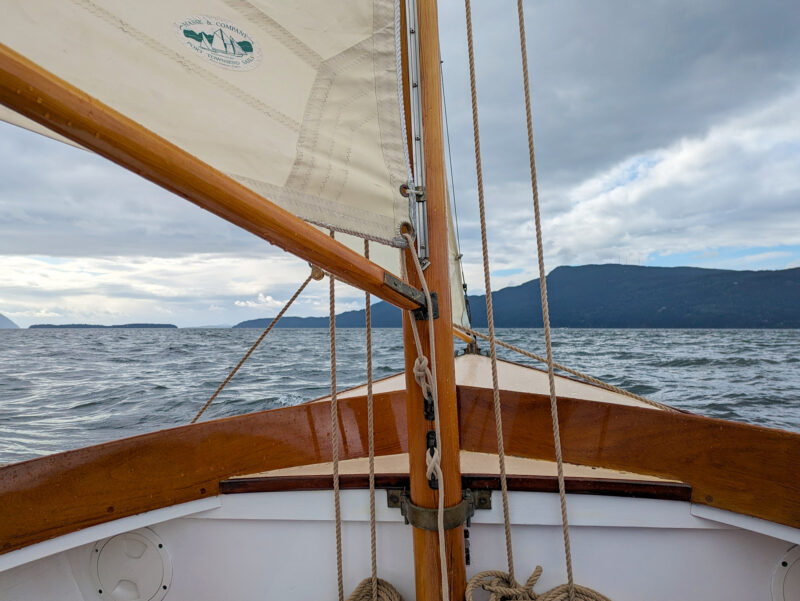
Just after departing Rolfe Cove, I sailed on a reach in the morning breeze toward Orcas Island. The mountain-ridge knob to the right of the starboard-most halyard is the summit of Mount Constitution. Soon after this I hoisted the spinnaker to head south down Rosario Strait.
I continued to ease off from the wind as LAZYDOG neared the skinny pairing of Clark and Barnes islands, so I raised the white spinnaker, and we were soon sweeping past the long white-sand beaches on their south ends. To the west, the stone tower high up on top of Mount Constitution was clearly visible but from such a height LAZYDOG must appear truly miniature. Mount Constitution often casts a large wind shadow when a west or southwest breeze blows across the San Juan Islands. The spinnaker buckled and drooped as we coasted out of reach of the westerly, and I doused it in anticipation of the light and shifty winds ahead. With 10 to 15 knots visible as a dark swath of water just a few miles away around Sinclair Island, I only had to get there before it died too. I pursued catspaws from every which way during my escape from under Constitution’s ridgeline, yet of the hour I spent ghosting along, I only shipped the oars for the final few minutes to round Orcas Island’s Lawrence Point into the new breeze.
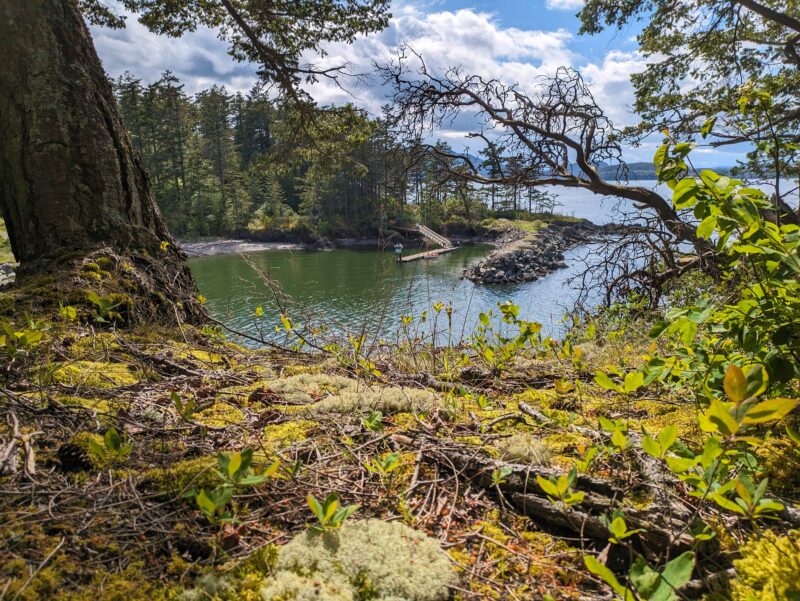
I docked on Vendovi Island just as the fickle wind died. Access to the island and time allowed at the dock are limited, so my stay would be a short one.
Picking up the new wind from Bellingham Channel I was making consistent progress once more—first on a tight reach, and then beating upwind to finally nose around Vendovi’s 150′ breakwater. I had initially been concerned about sailing into such a small enclosure, in case other boats were maneuvering in the cove, but seeing the dock nearly empty I first lowered the jib, followed by the main before stepping off onto the concrete dock just as LAZYDOG’s momentum faded. I’d made it just in time too, for the breeze that had carried me the last few miles died as I ate a late lunch overlooking Rosario Strait. If I was going anywhere without rowing, I had some time to kill. With the hope that the southerly would return, I set off to explore the island’s arching pebble beaches and sword-fern-lined paths to a bluff viewpoint looking south toward Guemes and Samish islands.
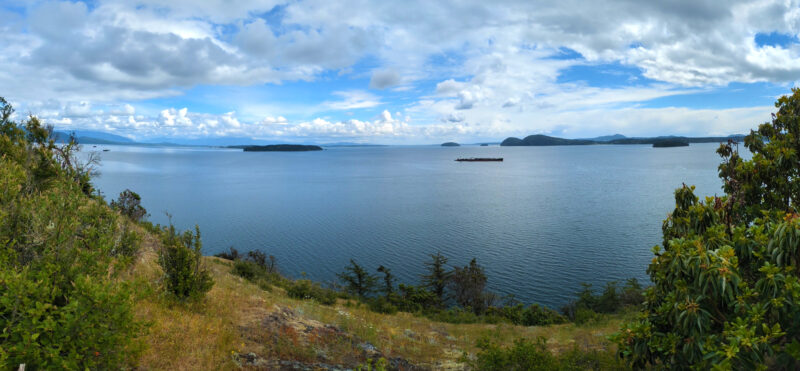
I hiked the one-mile trail to Vendovi’s southern bluffs where there is an expansive view of Guemes Island and many other small islands dotting the protected waters of Padilla Bay.
A few hours later I was back at my lunch overlook and watching as dainty catspaws dotted the glassy surface between Vendovi and Eliza islands. The signs of the breeze were a sure signal that it was time to hoist the sails and get on with the day, so I headed back to the dock and was soon underway. Purple martins, perched at the holes of their dockside nest boxes, eyed me as I cast off. Yet I was soon out of their gaze, delicately coaxing the spinnaker to hold the whispering southerly breeze as the afternoon turned into evening.
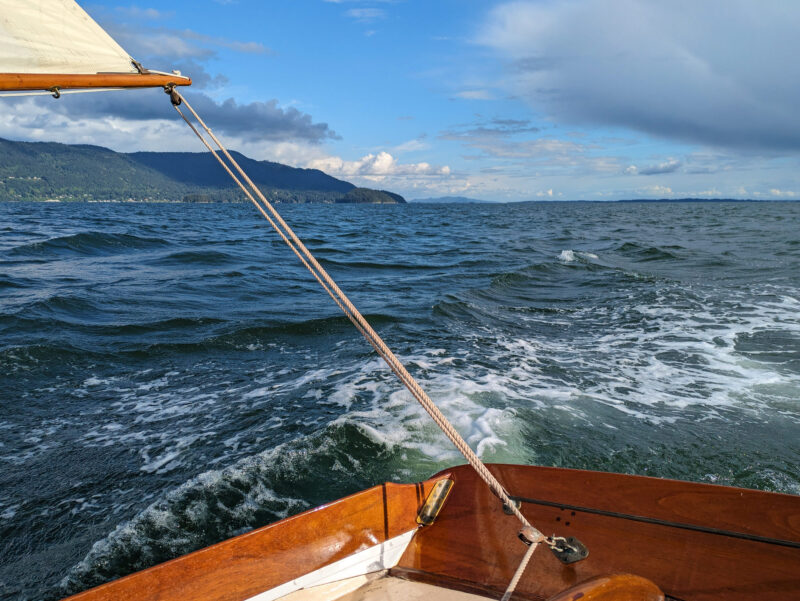
LAZYDOG rips back into Bellingham Bay under her spinnaker. The impending rain clouds to the right brought great sailing for the end of the trip and blew themselves out before dousing us.
As a new 10- to 15-knot wind built from the southwest, the spinnaker no longer required my babying to stay full and carried LAZYDOG toward the mouth of Bellingham Bay at a purposeful pace. Cruising past the homes dotting the eastern side of privately owned Eliza Island, I had a decision to make about how to conclude my shakedown trip. My original plan had been to make the short jaunt west to Inati Bay only 1 ½ miles farther northwest and spend another night at anchor. The updated forecast for the next day was for variable winds less than 5 knots, meaning a long and hot row across Bellingham Bay in the morning. LAZYDOG is a 1,600-lb boat before gear or passengers are added, and rowing her for over an hour, even in calm conditions, is a backbreaking endeavor. As LAZYDOG pressed downwind toward Fairhaven, the decision to return home a day early was an easy one to make. I have always been a sailor first, and took the opportunity to finish my trip under a full spinnaker and following seas.
As I sailed the final leg into Bellingham Bay, clouds stacked up behind the building wind and doused Lummi Island with rain, which formed a gray mist across its 1,400′-high ridge. Yet the clouds never caught LAZYDOG as she raced downwind. Eventually, the spinnaker had to come down in the lee of the steep and rocky Chuckanut Hills. After reaching around Post Point, I jibed toward the Fairhaven ramp.
Closer to shore I doused the sails to coast gently into the launch-ramp dock and stepped off LAZYDOG, pleased with my two-day spin to Matia and back. With everything onboard functioning as intended, I was looking forward to the summer cruising season.![]()
Sean Grealish lives and sails in Bellingham, Washington, where he is an environmental science master’s student at Western Washington University studying the impacts of estuary restoration on invertebrates. He grew up racing dinghies before completing two Transpac races and skippering the (then) youngest team ever to finish the R2AK in 2018. He now enjoys a calmer sailing lifestyle, squeezing in trips to the San Juan Islands whenever he can on his family’s Haven 12 ½, LAZYDOG.
If you have an interesting story to tell about your adventures with a small boat, please email us a brief outline and a few photos.


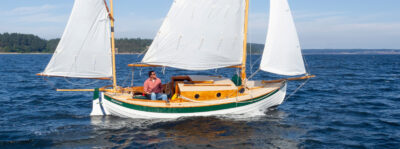
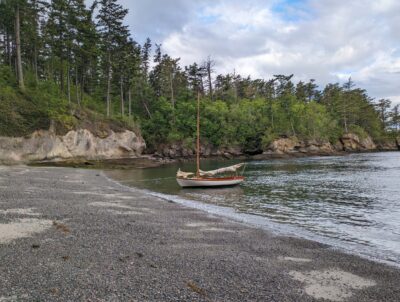


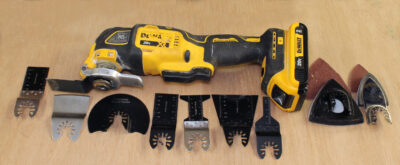
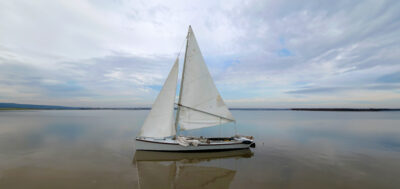
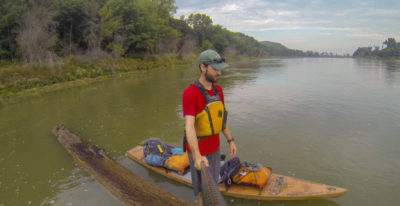
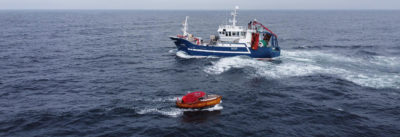
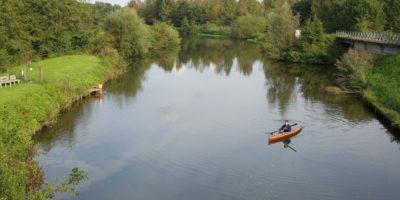
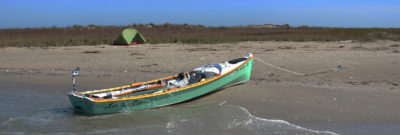
I kayaked among the San Juans decades ago. Always meant to return under sail but that is still in my bucket list.
Wonderfully observant and descriptive writing….and understated. It’s not trivial managing higher winds against tide in a 12 1/2. Capable as they are, freeboard is still low and swamping is a real risk. Captain Nat Herreshoff knew that, and designed front and rear watertight compartments (perhaps recalling his own youthful adventures whilst designing the “Buzzard’s Bay Boys Boat”)
But to flesh out the bio a bit for other readers, Sean was sailing these waters in this boat at 18 months onwards, so he “knows” it a fair bit better than most (says the proud dad).
The article does clear up a recent conversation we had before the unmentioned trip:
Sean- Do you think that forward watertight compartment would keep Lazy Dog afloat?
Dad- Yeah pretty sure….why?
Sean- Just wondering…
As beautiful as the writing, and scenery, are, wish you had shown a bit more of the interior, and closer pics of the boat overall, of this apparently very well kept 25 year old Haven 12 1/2.
I really enjoyed your story about the season’s shake-down cruise on the Haven 12 1/2 and it brought back many memories visiting my parents who bought a house on Chuckanut Dr. after my father retired in the late 1980s. Although I’m an avid sea kayaker, the only time I was on a boat in that area was paddling my father’s Old Town canoe in the bay below Chuckanut hills.
Thanks for the great story and accompanying pictures of such a beautiful part of the world.